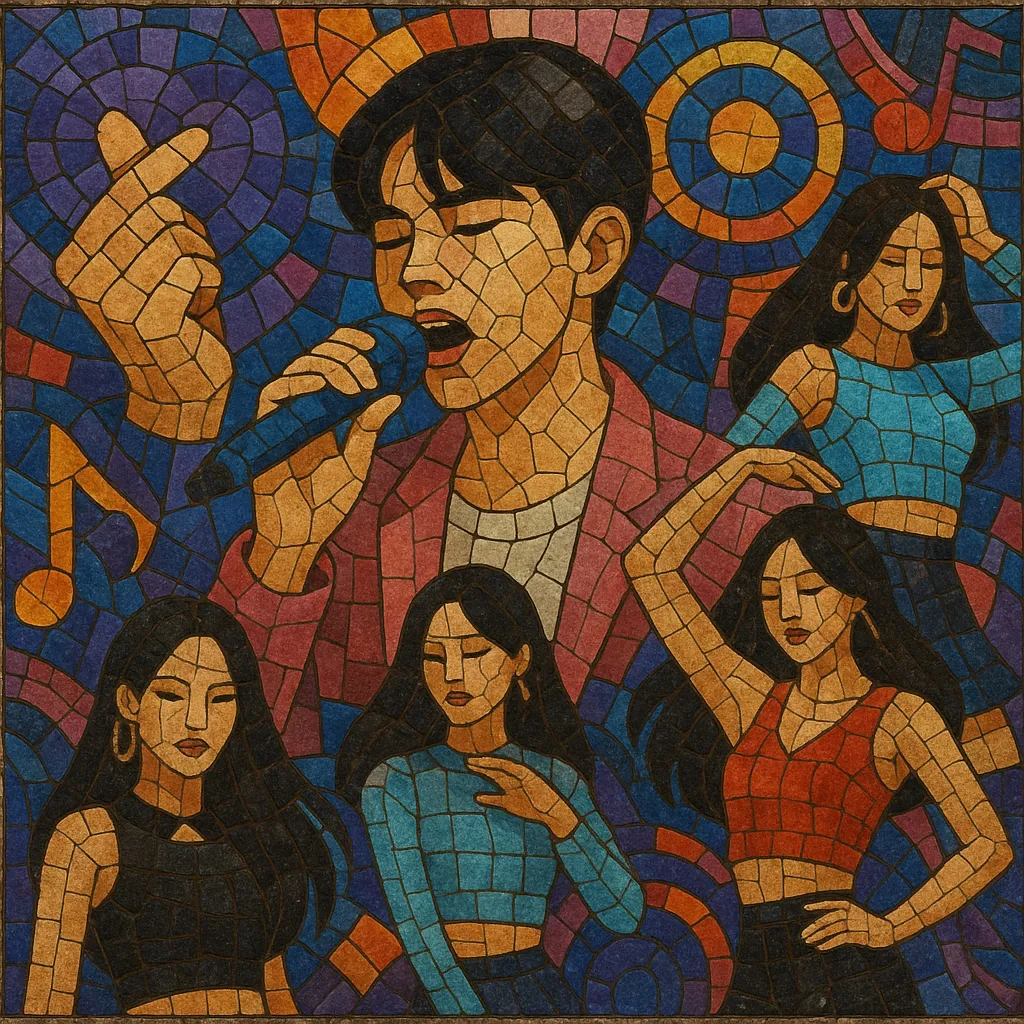K-pop is a contemporary popular music genre from South Korea that blends Western pop, hip hop, R&B, electronic dance music, and local sensibilities into highly polished, multimedia-driven productions.
It is characterized by hook-heavy songwriting, modular song structures with dynamic section changes, crisp choreography, concept-driven visuals, and intensive idol training systems.
Songs frequently mix Korean with English phrases, employ layered vocal harmonies and rap breaks, and are supported by elaborate music videos and synchronized stage performances that are integral to the genre’s identity.
K-pop’s modern form is widely traced to 1992, when Seo Taiji and Boys fused new jack swing, hip hop, and dance-pop on Korean television, challenging the ballad-dominated mainstream. Their success catalyzed a new industry model centered on trainees, performance, and trend-forward production. First-generation idol groups such as H.O.T., Sechs Kies, and S.E.S. embraced Eurodance and synth-pop, while solo artists like BoA helped open regional markets.
In the 2000s, entertainment companies systematized the trainee pipeline, invested in songwriting camps, and targeted Japan and greater Asia. Acts like TVXQ, BIGBANG, Super Junior, Wonder Girls, and Girls’ Generation increased global visibility. The rise of YouTube and social media enabled international fandoms and viral choreography, exemplified by Wonder Girls’ “Nobody” and later PSY’s worldwide smash “Gangnam Style.”
Third-generation groups—EXO, BTS, TWICE, BLACKPINK, and Red Velvet—refined a hybrid sound that drew from EDM, trap, pop-rap, and contemporary R&B, pairing it with cinematic videos and world tours. Fan communities developed distinct practices (lightsticks, streaming parties, fan chants), while labels adopted global co-writing networks and multilingual releases. BTS’s record-breaking chart performance and BLACKPINK’s streaming dominance solidified K-pop as a global pop force rather than a regional niche.
Groups such as Stray Kids, TXT, ATEEZ, ITZY, aespa, and NewJeans expanded the sonic palette with experimental structure, hyperpop-adjacent textures, and Y2K/retro aesthetics. Survival shows and global auditions diversified membership and fanbases, while short-form video accelerated virality. K-pop now functions as an export ecosystem—music, choreography, fashion, and fan culture—shaping pop scenes across Asia and influencing production methods worldwide.
Start with a modular structure that maximizes contrast and memorability: intro, verse, pre-chorus build, explosive chorus, post-chorus hook, verse 2 (often with rap), bridge or beat switch, dance break, and a final chorus (commonly with a key change or added layers). Plan clear dynamic arcs and unexpected transitions that feel cinematic but cohesive.
Use bright, hook-driven melodies with memorable motifs. Favor contemporary pop harmonies (I–V–vi–IV and variants), modal color (e.g., Mixolydian), and borrowed chords for lift in pre-chorus or bridge. Craft multiple hooks—main chorus topline, post-chorus chant, and instrumental motif—so different sections stick.
Target tempos around 90–110 BPM for groove-oriented tracks or 115–130 BPM for four-on-the-floor dance cuts; adopt 70/140 BPM half-time feels for trap-inflected sections. Layer tight drums with punchy kicks, crisp claps/snares, syncopated percussion, and precise hi-hat programming. Use modern builds (risers, snare rolls, filter sweeps) and impactful drops.
Blend EDM sound design (supersaws, sidechain pads, tonal risers) with pop textures (pianos, guitars) and urban elements (808s, chopped vox). Employ ear-candy throughout—fills, reverses, micro FX—and consider a mid-song beat switch or genre pivot. Keep arrangements dense but clear via frequency zoning and automation.
Stack layered harmonies and doubles for choruses; arrange call-and-response between vocalists and rappers. Balance Korean lyrics with concise English catchphrases for global recall. Focus themes on confidence, love, youth, and empowerment. Tailor lines to members’ vocal colors and create a memorable group chant for live fan interaction.
Design a performance-first chorus with a signature move and clean formations. Align sonic hits with choreo accents. Build a cohesive visual concept (styling, set colors, narrative) that the song supports, ensuring the MV and stage can amplify the track’s hooks.
Aim for punchy, polished mixes with defined low end (kick/808 management), present mids for vocals, and a glossy top end. Use bus compression for glue and automate energy lifts per section. Print instrumental and vocal versions for performance and promotional needs.


